According to UNESCO, Nizhny Novgorod is included in the list of the most valuable cities in the world for history. Founded in the 13th century as a reliable fortress, over several centuries it has turned into a rich, prosperous settlement with strong merchant traditions. Everything here breathes history - the powerful Nizhny Novgorod Kremlin, the mansions of old merchant families in the central squares, the painted domes of Orthodox cathedrals.
One alternative way to visit the city is to take a river cruise on the Volga. Almost all cruise routes are laid out taking into account the ship's call to Nizhny Novgorod. Travelers are waiting for exciting excursions and meals in traditional Russian taverns. It will also be interesting to come during one of the many fairs or ethnographic festivals that are held in Nizhny Novgorod.
What to see and where to go in Nizhny Novgorod?
The most interesting and beautiful places for walking. Photos and a short description.
- Nizhny Novgorod Kremlin
- Limpopo Zoo
- Nizhne-Volzhskaya embankment
- Upper Volga embankment
- Chkalov staircase
- Embankment Fedorovsky
- Bolshaya Pokrovskaya Street
- Technical Museum
- Nizhny Novgorod State Art Museum
- Nizhny Novgorod Drama Theater
- Nizhny Novgorod Opera and Ballet Theater
- Museum of the History of OAO GAZ
- Museum Steam Locomotives of Russia
- Russian Museum of Photography
- Literary Museum. Gorky
- Alexander Nevsky New Fair Cathedral
- Michael the Archangel Cathedral
- Nativity (Stroganov) Church
- Church of the Nativity of John the Baptist at the Market
- Spassky Old Fair Cathedral
- Caves Ascension Monastery
- Annunciation Monastery
- Main Fair House
- Manor of the Rukavishnikovs
- House of Sirotkin
- Building of the State Bank
- Monument to Minin and Pozharsky
- Monument to Valery Chkalov
- Monument to Maxim Gorky
- Nizhny Novgorod cable car
- Nizhny Novgorod Stadium
- Victory Park
- Shchelokovsky farm
- Park Switzerland
- Volga river
Nizhny Novgorod Kremlin
An impregnable fort of the 16th century in the central part of Nizhny Novgorod, which no one could take. 13 towers and a fortress wall more than two kilometers long have survived to this day. The thickness of the wall at the base reaches 5 meters, behind the fortress fence are the residences of city and regional authorities. Exhibition expositions are placed in the Kremlin towers, a section of the wall is open for tourists to visit.
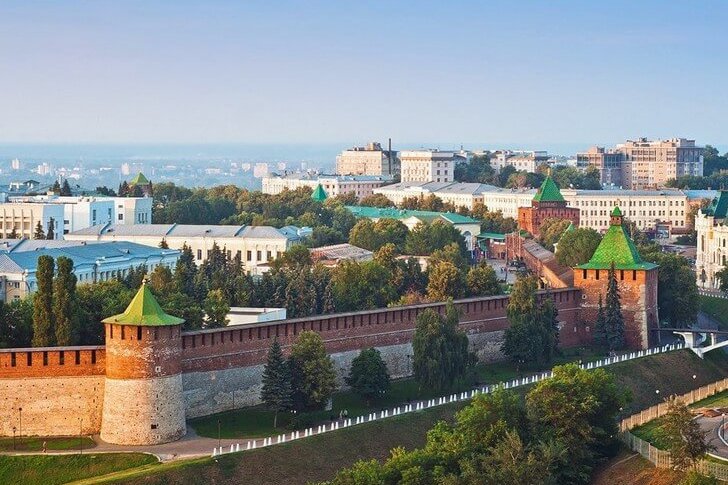
Limpopo Zoo
A small private zoo with 230 species of animals. Jaguars, ostriches, cougars, cranes, bears, Amur tigers and other fauna live here. In 2009, a petting zoo was opened on the territory, stylized as a Russian peasant farmstead. New animals are purchased at the expense of the owners of the menagerie, as well as thanks to the gifts of some patrons.
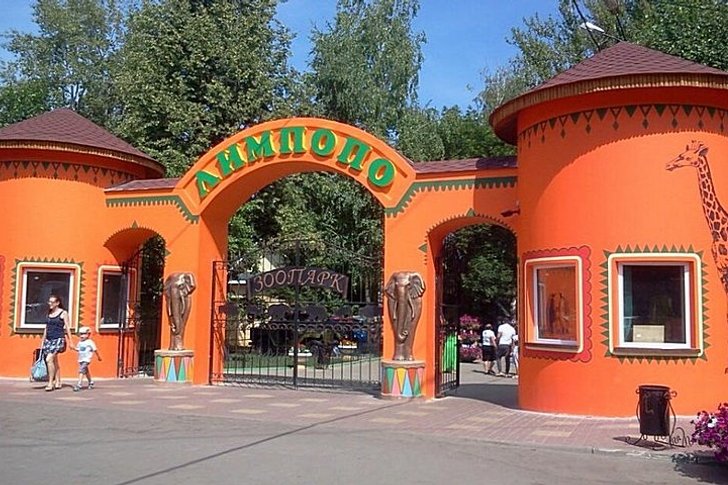
Nizhne-Volzhskaya embankment
Laid along the Volga coast between the Kanavinsky bridge and the Kazan congress. For 10 years until 2018, reconstruction was carried out, and the embankment was closed with a large construction fence. It is currently divided into two levels, including the carriageway and pedestrian areas, as well as bike paths. The length is 3 km. The main attractions are the Chkalov Stairs and the river station.
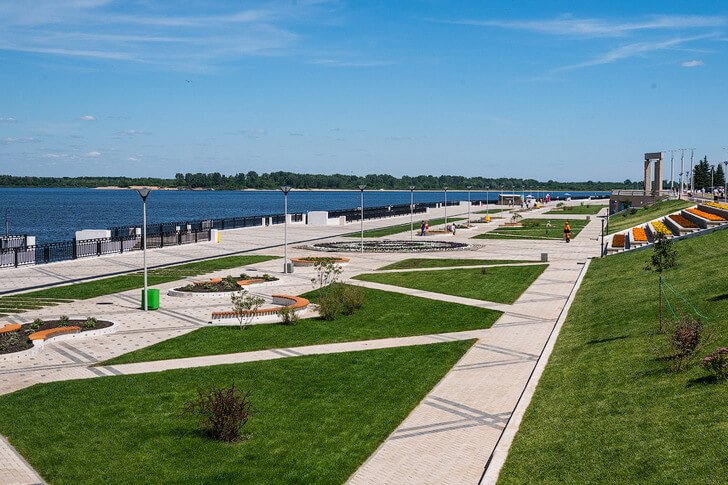
Upper Volga embankment
It extends in the historical part of Nizhny Novgorod between Minin and Pozharsky and Sennaya squares. The construction was initiated by Nicholas I: during his visit to the city, the emperor was dissatisfied with the state of the territories adjacent to the coast. Ruin and shacks spoiled the impression of walking and watching the Volga. Along the embankment are architectural sights.
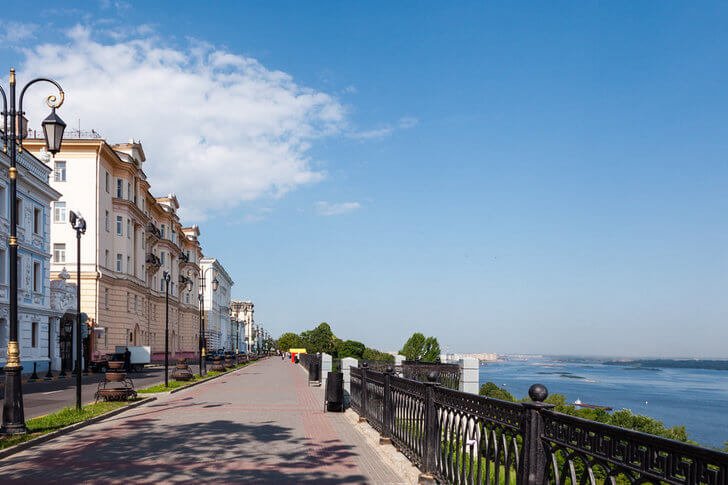
Chkalov staircase
A staircase with more than 500 steps that leads from the Volga embankment to Minin and Pozharsky Square. The building was built in honor of the victory in the Battle of Stalingrad. The work was completed in 1949. The staircase looks like a giant number "8". Due to its monumental size, it is perfectly visible from the opposite bank of the river. At the top there is a monument to the pilot V. Chkalov.

Embankment Fedorovsky
A well-equipped promenade with a magnificent view of the Oka River, the Kanavinsky Bridge and the Stroganov Church. This is one of the best urban observation platforms. There is a monument to Maxim Gorky on the embankment. The place has long been chosen by the newlyweds, here they constantly arrange photo shoots and launch pigeons. Anyone can find peace and solitude among the alleys of the embankment.

Bolshaya Pokrovskaya Street
The main street of Nizhny Novgorod, built up with noble mansions of past centuries. A large part of Bolshaya Pokrovskaya is reserved for a pedestrian zone. There are many interesting sights here: Verkhne-Posadsky chambers of commerce, drama and puppet theaters, the House of Trade Unions. The street became the main city avenue in the 18th century. At first, only representatives of noble families walked here.

Technical Museum
In 2014, an exhibition of mechanisms from the 19th–20th centuries opened in 3 halls on an area of 3,000 m². Subsequently, more ancient artifacts appeared. Some of them, like steelyards or a gear-drilling machine, are no longer in use, so it will be difficult for visitors to understand what is in front of them without a hint. You can explore the museum on your own, or book a tour accompanied by a research assistant or an audio guide.

Nizhny Novgorod State Art Museum
It was created on the initiative of the painter A. Karelin and professor of the Academy of Arts N. Koshelev. The opening took place in 1896. The basis of the collection was made up of canvases donated by Repin, Makovsky, Bogolyubov and other painters. After the Revolution of 1917, works of art removed from noble collections and private collections migrated here. Many of the paintings were obtained by the museum staff themselves.

Nizhny Novgorod Drama Theater
The city academic theater of the late 18th century, one of the oldest in Russia. The first performance for the general public was staged based on the work of D. Fonvizin. At first, serfs played in the troupe. The first building was not graceful, and contemporaries described it as "a gloomy and awkward building." However, as a result of numerous reconstructions, the theater acquired an attractive appearance.
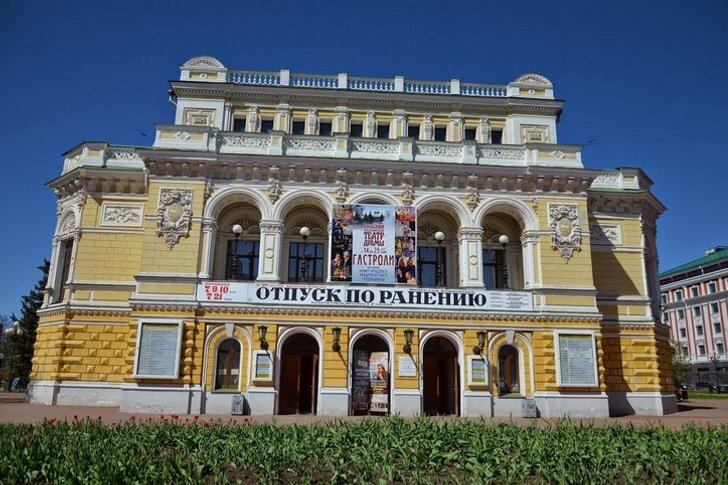
Nizhny Novgorod Opera and Ballet Theater
At the time of opening in 1935, the theater was called musical. He received the title of Academician only in 1994. Business cards - productions of "Prince Igor", "Lakme", "Judith". A distinctive feature of the theater is the search for new forms of interaction with the audience. Classical works are always in the repertoire, but there are also enough innovative ones. For almost 30 years, the theater has been hosting the Boldino Autumn festival.

Museum of the History of OAO GAZ
The museum houses expositions telling about the history and development of the Gorky Automobile Plant. Here is a collection of vintage cars (all cars are in working condition) and archival materials of the enterprise. Visitors can look at the famous models: "Seagull", "Volga", the Soviet truck "GAZ-51" and many others. In addition to preserving the exhibits, the museum tries to form a positive public opinion about the enterprise.

Museum "Steam Locomotives of Russia"
It is located on the territory of the village Sortirovochny. Locomotives that plowed the railways at the beginning of the last century are assembled here under the open sky. 15 exhibits have been carefully restored and are ready for inspection. They were released not only in the USSR, but also in other countries, for example, in Germany and Sweden. You can enter some cabins and even climb a special ladder to the roof of the P36-0071 steam locomotive.
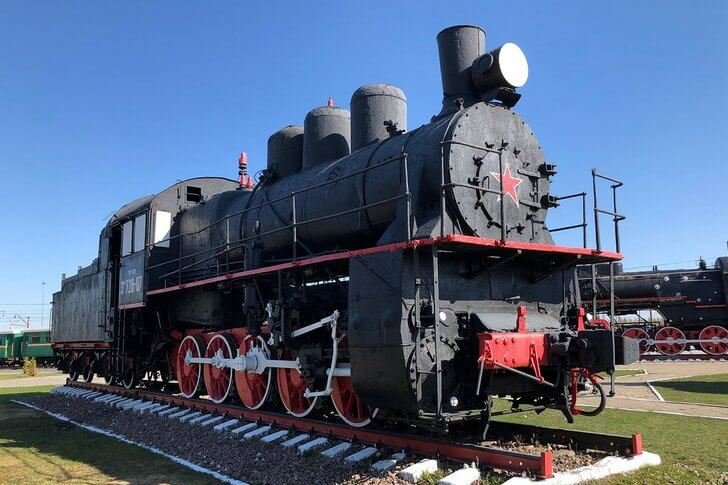
Russian Museum of Photography
The former photo pavilion was converted into a museum not so long ago. Photographers Maxim Dmitriev and Andrey Karelin worked here in the past. The equipment and personal belongings of the masters are the basis of the collection. Visitors will learn about the details of the process of creating photographs in the last century, look at rarities and photographs taken using this technique. On the basis of the museum there are two photo clubs, as well as photo exhibitions.
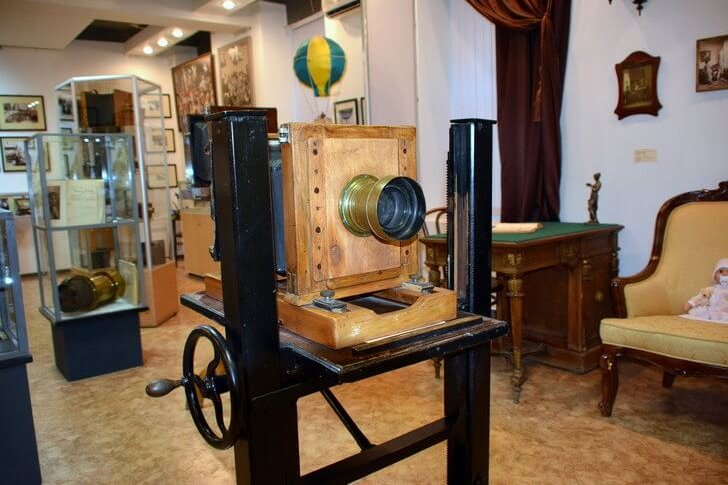
Literary Museum. Gorky
A collection that highlights the life and work of M. Gorky. The museum was opened for the 60th anniversary of the writer on the initiative of the townspeople. The archives contain manuscripts of local authors of the 19th century, as well as those writers whose creative activity was connected with Nizhny Novgorod. The unique interior of the beginning of the 20th century has been preserved in the building. There is also an exposition dedicated to St. Seraphim of Sarov.

Alexander Nevsky New Fair Cathedral
Temple of the 19th century, erected at the site of the Nizhny Novgorod fair at the expense of the merchants. The merchants wanted to commemorate the visit of Emperor Alexander II with this. During the Soviet period, the temple was neglected and stripped of all its valuables. The interior was completely destroyed by fire. Restoration work began in 1983, after 10 years the building was returned to the Church. In 2009, the cathedral received the status of a cathedral.

Michael the Archangel Cathedral
The chronicle of the cathedral begins at the beginning of the 13th century, when a church was built on this site. The current version of the temple appeared 4 centuries later. At the same time, as a basis, the architects chose not the most typical style for that period - hipped roof. In the Soviet years, the building was given over to a branch of the historical museum. In our time, the temple was returned to its former status and even 9 bells were installed. The weight of the largest exceeds 500 kg.

Nativity (Stroganov) Church
An elegant temple, which bears the name of the famous Russian industrialist Grigory Stroganov (it was at his expense that the construction was carried out). The external decoration of the church is an elegant white stone carving, which looks favorably against the background of red brick walls. The church underwent a major restoration in 1913. The church managed to avoid destruction during the Soviet era, as its rector was able to prove to the new authorities the historical value of the building.
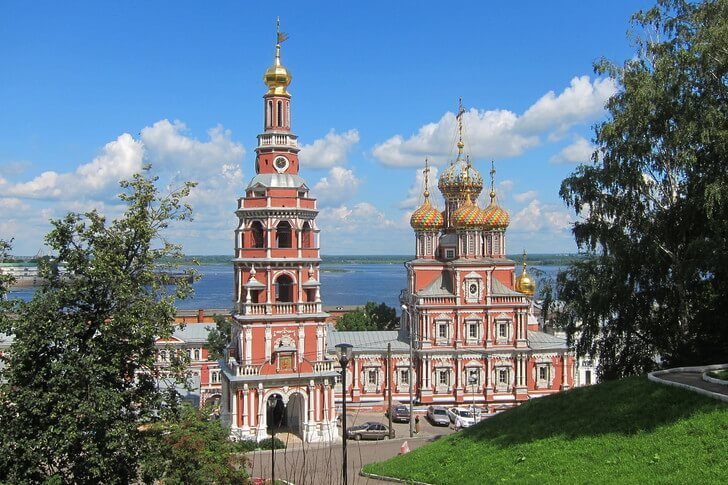
Church of the Nativity of John the Baptist at the Market
The 16th century church, famous for the fact that from its steps Kuzma Minin urged local residents to organize and move towards the liberation of Moscow (this was during the Time of Troubles). At first, on the site of the church, there was a wooden building dedicated to the future heir to Tsar Vasily III. Later, the church was rebuilt from stone, as the wooden building was prone to fires. The holy relics of Nicholas the Wonderworker and John the Baptist are kept inside.
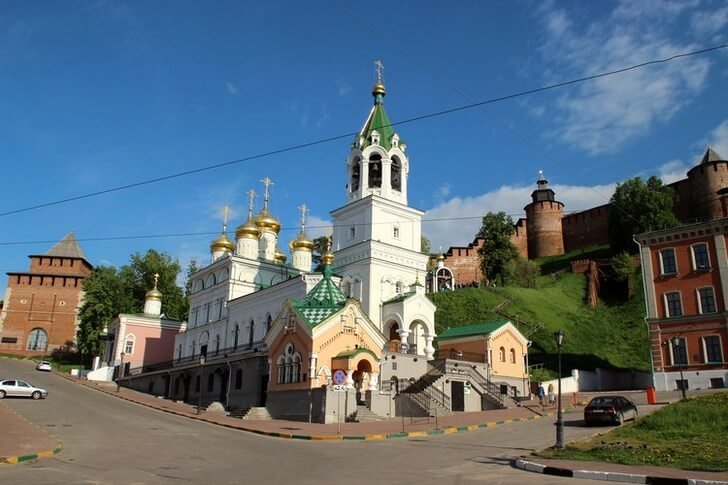
Spassky Old Fair Cathedral
The oldest building of the Nizhny Novgorod Fair. Auguste Montferrand, the architect of St. Isaac's Cathedral, was responsible for the project for its creation. Interior and exterior decoration is characterized by a large number of decorations and small interior details. In Soviet times, services were not held, and the premises were used for other purposes. In the early 90s, the temple was returned to the diocese, and in 2009 it received the status of a cathedral.
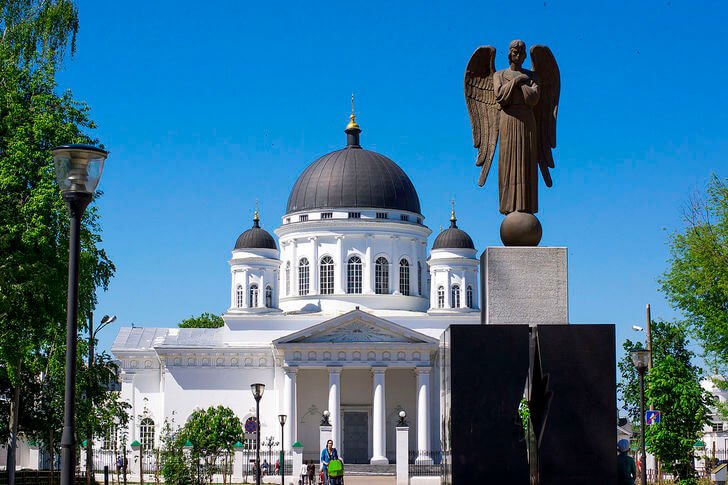
Caves Ascension Monastery
A male monastery on the banks of the Volga, founded in the 14th century by a monk from the Kiev-Pechora Lavra. In the Middle Ages, it was considered an important spiritual center of Orthodoxy in the Volga region. In the 16th century, as a result of a strong landslide, the monastery was destroyed, but the monks managed to save church valuables and property. The monastery was moved up the river. The architectural complex that has come down to us is the buildings of the 17th century.
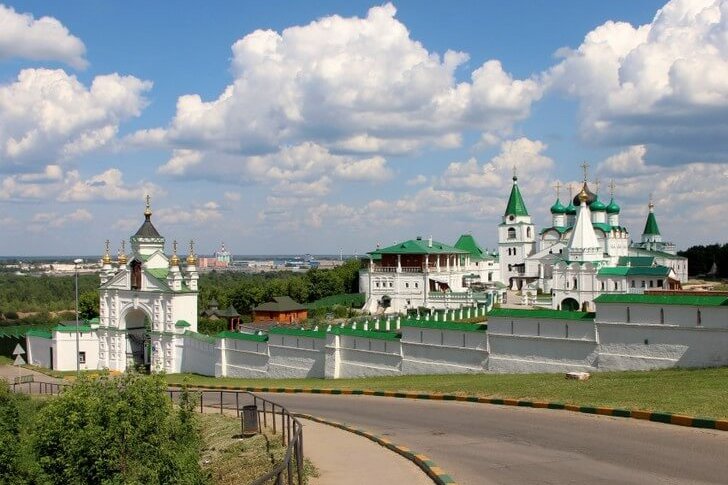
Annunciation Monastery
Founded in the XIII century, but the surviving buildings of the architectural complex date back to a later period. For example, the five-domed cathedral was built in 1649. The monastery underwent the first scientific restoration in Russia in the 70s of the 19th century. Since in the 50s of the last century a planetarium worked on the territory of the monastery, and a number of buildings were changed, in our time the complex needed restoration.
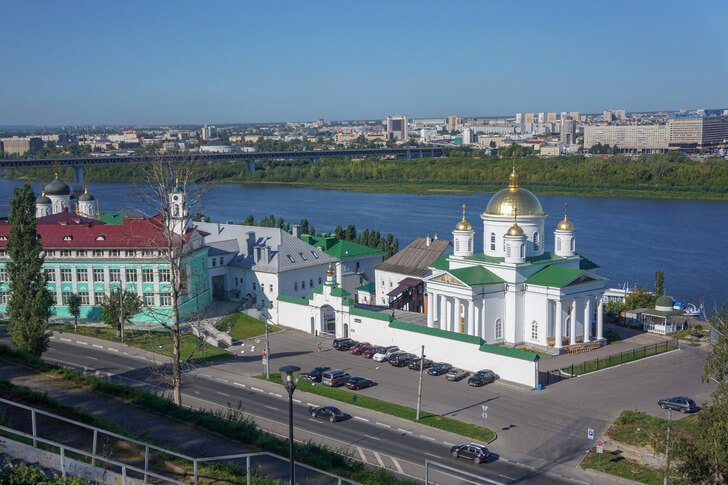
Main Fair House
A unique building that adorns the central part of Nizhny Novgorod, where for many years the largest Nizhny Novgorod fair in the Russian Empire was held. After the fire of 1816, the emperor personally ordered that funds be allocated for the restoration of the Fair House. The money was "torn off" from the restoration of the Winter Palace. The building is a national monument of history.

Manor of the Rukavishnikovs
Object of cultural heritage of the XIX century. The mansion was owned by the family of the industrialist Rukavishnikov, who turned an ordinary merchant's house into a real city palace. The facade was generously decorated with bas-reliefs and figures; elegant ceiling and wall paintings appeared in the halls. At the end of the 19th century, the mansion was the most luxurious house in Nizhny Novgorod. During a tour of the building, you can learn the history of the Rukavishnikov family.
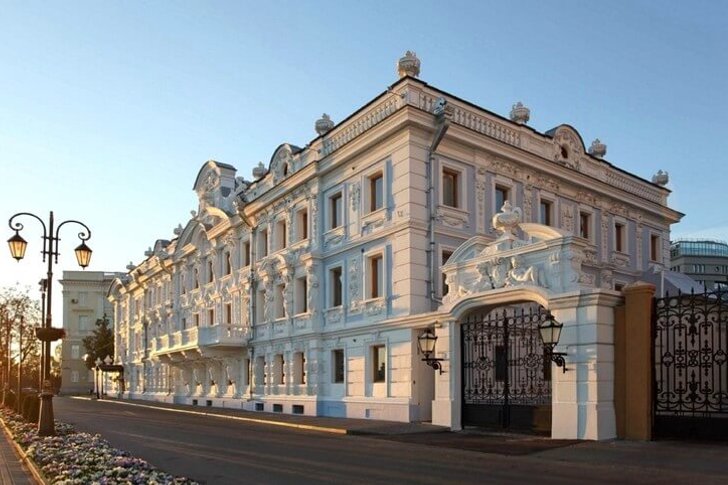
House of Sirotkin
The mansion of the merchant Sirotkin is located at the intersection of the Upper Volga embankment and the Nizhny Novgorod Otkos. It was built in 1916 according to the project of the three Vesnin brothers, architects from the capital. After nationalization, the building was transferred to the art museum. One of the main exhibits is a huge canvas "Appeal of Minin". Its author Makovsky depicted a complex historical plot using about 100 portraits.
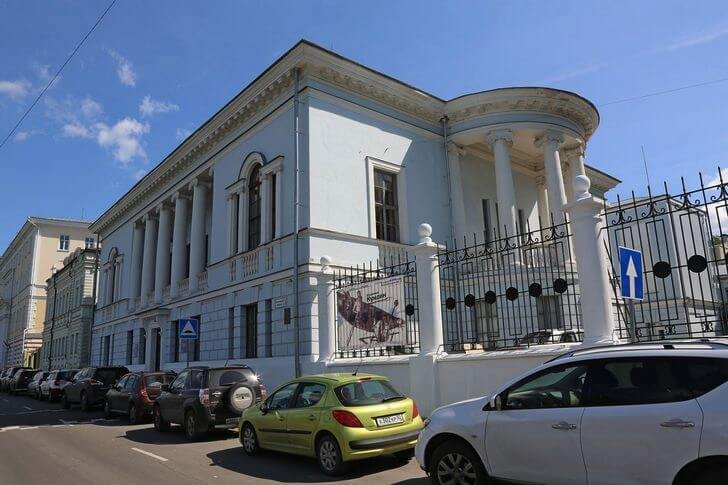
Building of the State Bank
A bizarre building of the beginning of the 20th century in the style that is commonly called "neo-Russian". It was erected for the 300th anniversary of the Romanovs. Emperor Nicholas II even visited here. The interior interiors are made in the imperial palace style, as was customary in the late tsarist era. The building has survived to this day intact and is used as a bank office.
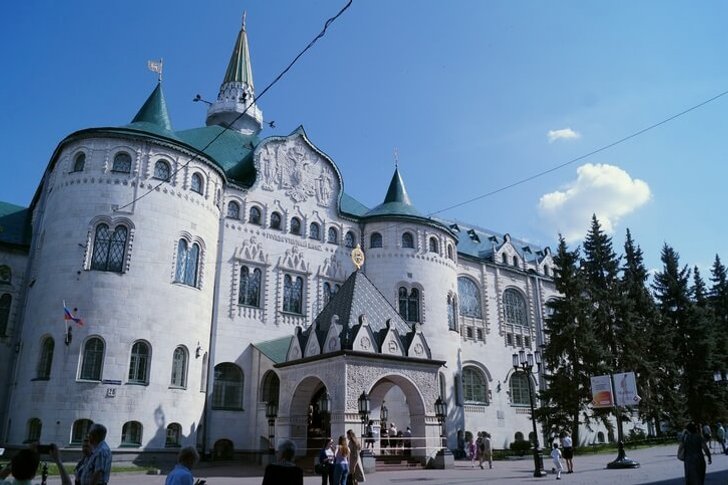
Monument to Minin and Pozharsky
A site near the Kremlin was chosen as a place for the installation of a monument to the leaders of the people's militia of the early 17th century. The attraction appeared in 2005 and completely repeats the Moscow original, albeit smaller in size, and without specifying a date. The author of the project is Zurab Tsereteli. To complement the composition and give it historical accuracy, an alarm bell was placed nearby.
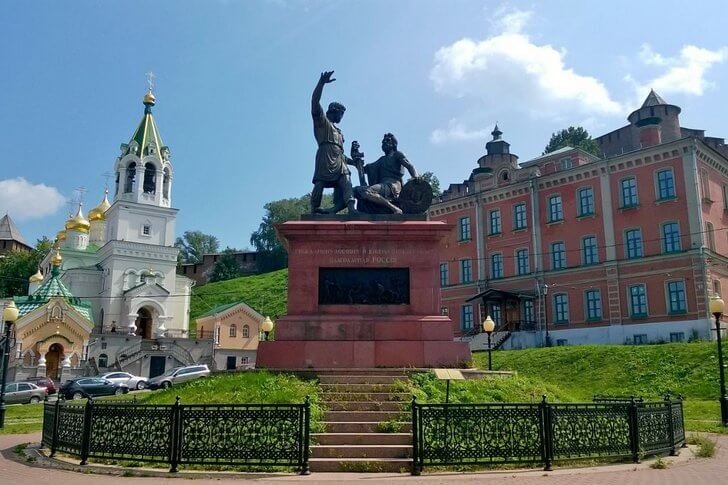
Monument to Valery Chkalov
The first pilot to make a non-stop flight over the North Pole was born in the Nizhny Novgorod region. In 1938, after the death of Valery Chkalov, the local authorities decided to perpetuate the memory of the countryman. The bronze figure of the Hero of the Soviet Union is installed on the embankment, exactly where he liked to walk during his visits to the city. There is an observation deck nearby, from where you can see the Strelka.

Monument to Maxim Gorky
Although the monument to the writer was opened only in 1959, plans for its creation were hatched for several decades. Even before the war, a competition was held, where the project of Vera Mukhina, the sculptor who presented the country with the “Worker and Collective Farm Woman”, won. A seven-meter bronze statue was installed in the city square. The image of the young Gorky is conveyed with documentary accuracy, which disposes tourists to the monument.
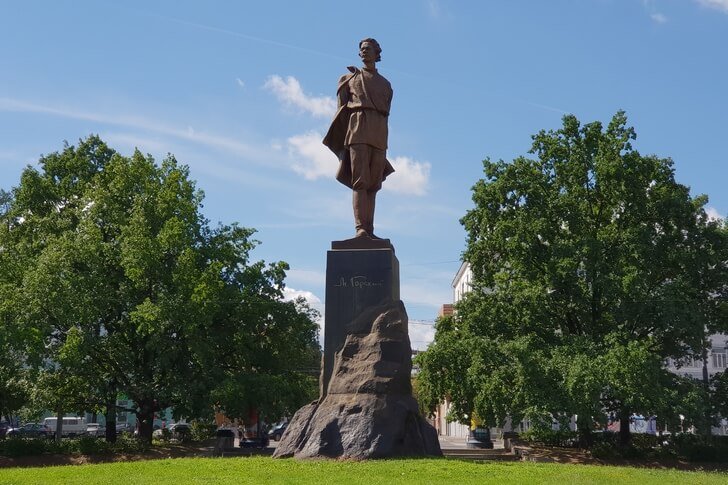
Nizhny Novgorod cable car
Cableway over the Volga River connecting Nizhny Novgorod with the city of Bor. This construction is the longest cableway in Russia. Thanks to this project, a convenient passenger crossing between settlements appeared. You can cross the cable car from one coast to another in 12.5 minutes. Up to 500 people can cross in both directions in an hour.

Nizhny Novgorod Stadium
Built for the 2018 FIFA World Cup in Russia. Strelka, where the Oka flows into the Volga, was chosen as the site for the stadium. Capacity - 45 thousand people. The sports complex is multifunctional: part of the premises is planned to be leased out, fairs will be held in the foyer, and, in addition to matches, concerts and major cultural events will be held on the field. Nearby is a park that replaced the old cargo port.
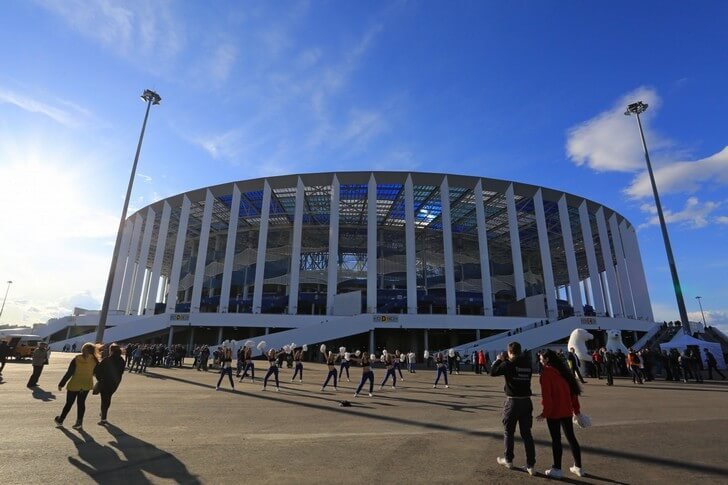
Victory Park
In 1985, for the next anniversary of the Victory, a park was laid out on the Nizhnevolzhskaya embankment. In 2012, it was supplemented with an open-air exhibition presenting military equipment and samples of the defense industry. A standard tour includes a tour and a guide about all 34 exhibits. On the basis of the museum, Zarnitsa and the game of "Gorodki" are held, registration for which is carried out in advance.
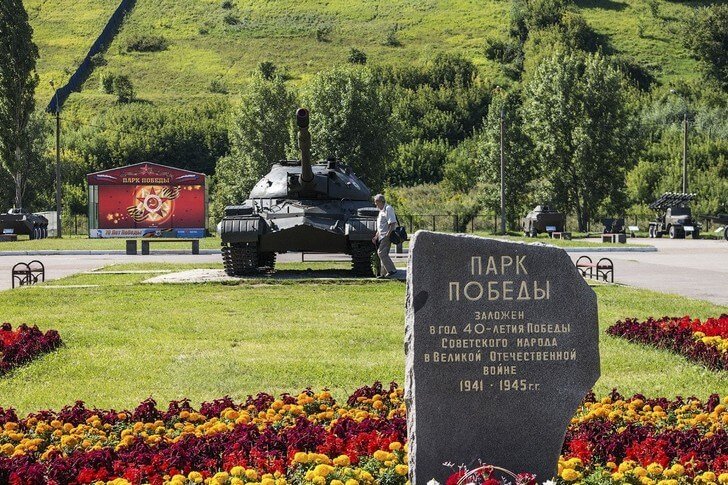
Shchelokovsky farm
One of the most interesting museums of the city is located on 38 hectares of the forest park of the same name. It opened in 1973, and was renamed and transformed into a museum-reserve in 2014. The exposition is dedicated to the architecture and life of the peoples of the Nizhny Novgorod Volga region. The buildings date from the 17th to the 19th century. Among them are several barns, huts, wells, churches. A total of 16 objects were collected in a state close to ideal.

Park Switzerland
A large park in the Prioksky district of Nizhny Novgorod. It is a large forest area - an oasis of freshness and greenery in the midst of a busy industrial city. The territory is equipped with walking paths and benches, so it is quite comfortable to spend the weekend here. The park has rides, a cinema, a go-cart track and even its own zoo.

Volga river
The Volga is the main river of the European part of the Russian Federation and its most important water artery. Along the river there are many ancient cities, one of which is Nizhny Novgorod. Here the Volga merges with the Oka and forms wide picturesque spills. The confluence of the rivers is called Strelka. This bend is considered a symbol of the city. Nearby is the river station, from where you can go for a walk along the picturesque Volga and admire the banks.
